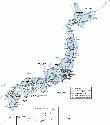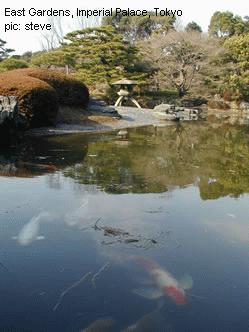Popular resorts
Introduction
You may know that Japan is famous for overweight men wrestling in giant G-strings, but are you aware that it boasts over 500 ski resorts? As a small country which is about 70% mountainous, wherever you are in Japan, there is bound to be a piste within reach, from the sub-tropical island of Kyushu in the south, to the Siberian-esque Hokkaido in the north.
That said, this huge number is a little deceiving. As with their cars, cameras and computers, the Japanese do with ski resorts what they do best: miniaturise. Though some resorts do match those in Europe and N. America for lift capacity, Japanese ski areas are generally much smaller, some consisting of just one lift and a single short run. However, the presence of the winter Olympics twice in this country proves that Japan has what it takes to provide world class riding, and more importantly, world class snow.
 In Japan you’ll find deep, light powder through paper birch studded slopes, warm hospitality, and vending machines that sell beer and young girls’ knickers. Many of the resorts offer night riding sessions, some till as late as 11pm, and there are even a few 24 hour resorts, perfect for those who may have slung too much sake down their throat.
In Japan you’ll find deep, light powder through paper birch studded slopes, warm hospitality, and vending machines that sell beer and young girls’ knickers. Many of the resorts offer night riding sessions, some till as late as 11pm, and there are even a few 24 hour resorts, perfect for those who may have slung too much sake down their throat.
Riding Conditions
Japan’s snow season generally runs from late November to early April, with a few resorts operating until May. The country cops cold air streams coming down from Siberia, which pick up moisture on their way over the Sea of Japan, and when they hit the mountains they bust their almighty load all in a big way. The result: a country that receives one of the highest snowfalls in the world.
The ski areas are spread over four main islands with the crème of the crop in the biggest island of Honshu and the northern island of Hokkaido. All but a handful of tiny ski areas allow snowboarding on their grounds, and many have decent terrain parks with halfpipes. Whilst Japan does have a population density higher than that of Europe, this doesn’t mean that the slopes are crowded. In fact, the Japanese tendency to work insanely long hours (i.e. 12 hour days, 6 days a week) mean that apart from Sundays, resorts are often very quiet. One-man powder sessions have been known, bringing a new meaning to the mantra “No friends on a powder day”!
As we all know, Japan has a reputation for being super high tech, having pumped out the Nintendos and Playstations to the rest of the world for years. However, in some aspects of western life they are still in the Stone Age. Although you would be hard pushed to find a drag lift in a Japanese resort, the existence of rusting, one-man chairs is particularly common. These are an experience in themselves: with no footrests or safety bars of any kind, you do feel a little on edge. Their toilets can be somewhat of a gamble too; either you get the full-on power arse washer model complete with heated seat and control console, or you get a hole in the ground.
Off The Slopes
You may have heard that the Japanese are a shy, reserved race, which is true to some extent. However, get out of the big cities to the more remote areas and you will be treated with genuine kindness and generosity. As one of the most homogenous countries on the planet, foreigners are generally viewed with great curiosity, especially outside of the well-worn tourist zones. Bust out a simple “konichiwa” (good day) or display your chop stick talents and you will be viewed with jaw dropping amazement by the locals. Many Japanese will be keen to try out their English on you, as they rarely get a chance to do so on a native speaker, so you can often find yourself the centre of attention, which usually works in your favour.
Males will be pleased to hear that J-girls dig western men. Perceived as being exotic, interesting, and apparently known for treating the ladies right, if you’re a “gaijin” (foreigner) you’ll attract attention from the opposite sex without even trying. Western females can find a J-boy to take home if they go to the right places, but in this country the tables are turned and it’s the guys who’ll be turning heads, rather than the girls.
The Japanese love to drink, and the availability of beer, sake and “shochu” (another rice based spirit) in vending machines is testament to this. Though resort nightlife doesn’t match that in the west, there are always a few bars where you can get friendly with the locals. Once the alcohol starts flowing, the Japanese lose all trace of their stereotypical shyness, so expect to be questioned about anything, from the length of your dong, to the size of your boobs.
One of the greatest things about Japan is the abundance of natural hot springs, known as “onsens”. With so much geothermal activity, onsens are everywhere and many ski resorts have them on site or close by. This is the perfect way to relax those aching muscles after a day on the slopes. These are all single-sex affairs as it is onsen law to bathe in your birthday suit. The standard procedure is to shower down first, then take a dip in the tub; bombing is most certainly a faux pas. For those that have ink, a word of warning: in Japan, tattoos are generally frowned upon by the older generation. This is because, until recently, tattoos were the trademark of Japanese Mafia (“Yakuza”) members. Be warned that many onsens bar entry to those with tattoos and some even display signs to this effect.
Aside from snow, Japan has tons to offer the traveller, from magnificent ancient temples, to the neon bustle of the cities complete with Karaoke bars and love hotels. Even the humble supermarket with its octopus tentacles, pig intestines, and unidentifiable vegetables, becomes a tourist attraction for the wide-eyed westerner. So it’s worth taking a few days off from the slopes to lap up a little eastern promise.
Money
There is an age-old misconception that Japan is a) expensive, and b) crowded. While a trip here is obviously going to cost more than a jaunt to Andorra or your local resort, the general cost of living is on par with the UK and the US, with many things being considerably cheaper. Petrol for instance, is about half the price of the UK and only a little more than the States. Come to Japan in March and hit up the spring snowboard sales in Tokyo, you’ll find some incredible discounts.
Lift Passes cost usually between ¥3,000 and ¥5,000 for a day, with only a small discount given for multiple days. Nevertheless, it is possible to buy half day and even single run tickets - a good money saver if the weather’s bad or you’re hung over. Despite Japan’s high tech reputation, credit cards are not widely accepted and it’s best to carry cash. It can be beneficial to purchase your lift passes at a convenience store (or “Conbini”) such as Lawson, Family Mart or Circle K, as you often get about ¥1,000 of lunch vouchers included in the price; a better deal than at the resort itself.
Eating out can vary in price dramatically depending where you are. You can spend as little as ¥300 by purchasing some hot noodles from a vending machine or as much as ¥10,000 for a classy 5 course meal. Certain districts in the cities will average higher prices and some resorts will always give your wallet a thrashing, but generally speaking Japan’s prices are very similar to Europe and N. America and they depend more on what Prefecture (region) you’re in.
Travel
Train 
Japan’s rail network can be expensive, but you get what you pay for – a clean, quick, punctual service, and it’s worth riding the Bullet Train (which is the world’s fastest), for the experience alone. If you expect to be using the trains regularly, buy a Japan Rail Pass (only available outside of Japan), which gives you unlimited travel for a fixed time period. Prices range from ¥28,300 for a 7day pass to ¥57,700 for a 21day pass. Storage for boards and other large luggage is not well catered for, so use a “Takkyubin” company. They provide a great service that delivers your gear to any address in Japan for a reasonable price, saving a lot of hassle. Look out for their service counters at airports and train stations.
Car
You’ll need an International Driving Licence to drive here. They drive on the left side, helpful for you Brits, and most road signs are in English. Watch out for kids and grannies cycling on the wrong side of the road - it seems to be legal here! Hire cars aren’t particularly cheap and the numerous toll roads can pump up the price of a road trip, so unless you’re in a group a car isn’t the best option.
Bus
There is an extensive bus network that will whisk you away to any resort in Japan. Overnight buses offer spacious reclining seats (a far cry from National Express or the Greyhound) and the competition is so strong that it’s easy to pick up a great package deal, including transport, lift passes and accommodation.
Useful addresses
International Snowboard Federation Asia MC Building 2F, 4-36-4 Yoyogi, Shibuya-ku, Tokyo 151-0053 Japan Snowboard Association (JSBA) MAC Shibuya Building 4F, 15-10 Nanpeidai, Shibuya-ku, Tokyo 150-0036, JAPAN Phone: +81 (0)3 5458 2661 Facsimile: +81 (0)3 5458 2662 URL: www.jsba.or.jp Japanese National Tourist Organization (JNTO) 10th Floor, Tokyo Kotsu Kaikan Building, 2-10-1 Yurakucho, Chiyoda-ku, Tokyo 100-0006 Phone: +81-3-3201-3331 URL: www.jnto.go.jp/eng/